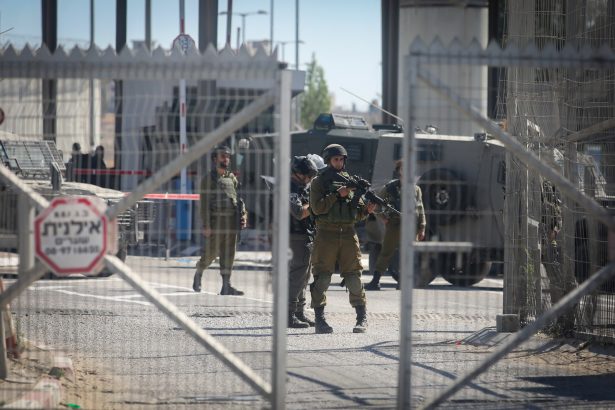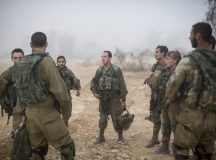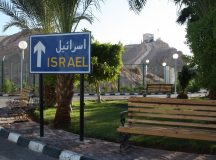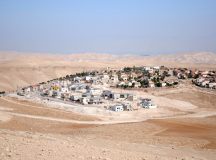Colonel Kris Bauman is Senior Military Fellow at the Institute for National Strategic Studies (INSS) at the National Defence University and in 2013-2014, worked as Chief of Staff for the Senior Advisor to the Secretary of Defence, General John R. Allen. Ilan Goldenberg is Director of Center for New American Security (CNAS) Middle East Security Program and Former Chief of Staff to the Special Envoy for Israeli-Palestinian Negotiations. Bauman and Goldenberg’s Fathom article explains how their paper builds on previous work in negotiations and aims to provide a starting point for further discussion and refinement in order to resolve the security component of final-status discussions between Israelis and Palestinians. Amongst other things, they are guided by the challenge of preventing the West Bank from going the way of Gaza after Israel’s withdrawal in 2005.
For the past year the CNAS has developed the most comprehensive public study ever released on security arrangements between Israelis and Palestinians in the context of a two-state solution. The work was informed by our own experiences as members of the American team during the last round of final status negotiations in 2013-14 and hours of consultations with Israeli, Palestinian, Jordanian, and American active and retired security and political officials. We concluded during those negotiations that Israelis will never agree to a permanent status, two-state solution unless their security concerns are addressed. Palestinians will not sign on to an agreement that includes unacceptable violations of their sovereignty or perpetuates what they view as an endless occupation. This tension is at the heart of the Israeli-Palestinian security dilemma and any security system must meet both sides’ needs.
Why present this now?
Before describing the details of the proposals, it is important to explain why we chose to pursue this work, especially at a time where there is no appetite among Israeli or Palestinian political leaders or the general population for a renewed peace process. We are under no illusions about that.
First, the issue has risen significantly in importance. During the 2013-14 negotiations, we were somewhat surprised to find that security had moved to the top of the list of intractable issues. If you speak to negotiators from Camp David (2000) or Annapolis (2007-2008), the biggest challenges were perceived at that time to be Jerusalem and refugees. On security, negotiators generally assumed the experts would be able to get together and work things out. But much has changed since 2000. Israel’s experiences after departing southern Lebanon, living through the second intifada, and dealing with the aftermath of the withdrawal from Gaza have changed the perspective of Israeli society. Security has gone from a technical issue to be resolved by experts to one that is central for the Israeli public and therefore requires more work. There will be no agreement unless an Israeli leader can clearly explain to the public why a Palestinian state in the West Bank will not just lead to another Gaza.
Beyond the elevated importance of this issue, experience reveals the value of continuing to work on these issues even when no process is underway. Back in 2013 when US Secretary of State John Kerry unexpectedly secured an agreement to resume negotiations, one of the first steps we took was to go back and review everything that had been done in previous rounds and by various external track two efforts. A fair amount of work had been done on borders, refugees, and Jerusalem, and that was enormously helpful as the US worked with Israeli and Palestinian negotiators to find creative solutions to these pressing challenges. But there was almost no detailed rigorous external work on security because it had previously not been as central of a challenge. We hope that by releasing this work now, that gap will be filled for future negotiators.
The report can also be helpful because it paints the picture of an achievable security end state that can guide Israeli, Palestinian, and American security efforts today. Because there is currently no political agreement on an end state, there is no clear vision of what the Palestinian Authority Security Forces (PASF) are supposed to become; in particular, there is no agreement on what their final capabilities should be. This creates difficulty for all three parties. The United States Security Coordinator (USSC) and their international partners do not have a target for training and equipping the PASF; the Israel Defence Forces (IDF) do not know what to support and what to object. The PASF is caught in the middle with no clarity as to what the Israelis and the international community will expect of them. This report offers an end state that all parties can begin to work toward, even before an agreement is signed.
Third, we wanted to demonstrate through a serious detailed study that security is truly achievable, and therefore, that security is not a valid reason to postpone serious negotiations on a two-state agreement. This is an important message, especially for the Israeli public who cares so deeply about this issue and whose support for a two-state agreement can give its elected leaders the necessary space to make tough decisions.
We have two other preliminary notes about the context and purpose of the study. First, the final report purposely included in the title the phrase, ‘Advancing the Dialogue’, because we do not consider the work complete. Rather, this is a living document that provides a starting point for further discussion and refinement and indeed builds on the previous work that has been done. We are not wedded to the proposals in this study as the be all and end all and indeed in a number of places we offer a series of options for negotiators to consider as opposed to just one solution. We hope to see the next level of detail developed as the dialogue continues.
Finally, our assumption on the interaction of all final status issues is that security will lean toward Israeli demands in exchange for borders leaning toward Palestinian demands. This is a formula that has been clear to negotiators for years. Therefore, if one were to offer the security proposals in this study to Palestinian leaders in isolation, they would be rejected. However, if these security proposals came in conjunction with a commitment to talk about 1967 borders with reciprocal swaps, then it could become the basis for further negotiation.
The security system
The security system would include four mutually-reinforcing layers: (1) internal security inside the new Palestinian State to counter the threat of terrorism and other internal challenges; (2) border security to prevent smuggling or cross border attacks; (3) non-ground domain security, including air, maritime, and the electromagnetic spectrum; and (4) regional security with the Arab states to further reinforce security for Israelis and Palestinians. Even beyond all of these layers, in extreme situations Israel would still have the capacity to take unilateral action to defend itself by itself.
Six key principles remained at the forefront of our thinking to answer the question, how do you keep the West Bank from going the way of Gaza after the Israeli withdrawal in 2005?
- Build a multi-layered system that addresses Israel’s security concerns in which Israel retains the right of self-defence as well as the capacity to defend itself by itself, but ensures this is only necessary in extremis. After the unilateral Gaza withdrawal, there was only one layer of protection and only one method of recourse if things went badly: re-invade. In this proposal, there are multiple, interlocking, mutually-reinforcing layers of security and insurance mechanisms to ensure there is no repeat;
- Minimise Israeli visibility to Palestinian civilians and pursue significant early steps that signal a fundamental change on the ground to Palestinians. This is critical to establish trust early, signal to Palestinians that Israel is committed to redeployment, and reduce the manoeuvre space of potential spoilers;
- Plan a conditions-based, performance-dependent, area-by-area phased redeployment of Israeli security forces with target timetables, benchmarks, and an effective remediation process. This ensures that no Israeli redeployment is taken prematurely before conditions are right but also gives the Palestinians assurances that there is a clear process for implementing the redeployment of the IDF;
- Conduct significant upgrades to security systems and infrastructure. Much of this can come through international and American support and improve security for all sides;
- Build joint operations centres and data sharing mechanisms for all parties such that there is maximum situational awareness of the security environment for Israelis but minimal intrusion on Palestinian sovereignty;
- Employ American forces for training, equipping, evaluating, and monitoring, and for conducting highly limited operations along the Jordan River. This is perhaps the most controversial issue for Israelis given their concerns about any third party force. The study offers a number of options for negotiators to consider, but believes this is the best of a number of imperfect options.
The internal Palestinian security system would include a non-militarised Palestinian security force whose maximum capabilities resemble a gendarmerie model. The PASF would also have a small, highly capable Palestinian Counterterrorism (CT) unit trained and equipped to a level analogous with a Special Weapons and Tactics (SWAT) unit of a large American city. The Palestinian system would be further bolstered with a full-spectrum, self-contained Palestinian counterterrorism system composed of vetted and protected personnel including intelligence officers to detect terrorist activity, CT forces to raid sites and arrest perpetrators, forensics experts for site exploitation, pre-trial detention officers to ensure prisoners do not escape, prosecutors and judges to conduct trials and issue warrants, post-trial detention officers to ensure prisoners are not released early, and finally, stand-alone detention facilities.
The entire system would contain joint operations centres that include Israeli, Palestinian, and American security forces for sharing intelligence, identifying potential targets, and coordinating operations. There would be multiple mechanisms for rapidly resolving disagreements between the parties on the merits or needs of a particular operation, including among security professionals, at the bilateral political level, and, where required, through American mediation.
The border security system between Jordan and the future Palestinian state would be far superior to the one that exists today. It would include crossing point facilities between Jordan and the new Palestinian state that would be staffed by the PASF (on the Palestinian side) and Jordanian security forces (JSF) (on the Jordanian side of a crossing) but would include American monitors on the Palestinian side who are qualified to re-inspect people or cargo if Israel deems it necessary. During the transition years, Israel would remain responsible for overall security at the crossing points, though with only a low-visibility Israeli presence that over time would transition to nonvisible and, if technology allows, eventually to electronic monitoring. A state-of-the-art traveller database would be shared by Israelis, Palestinians, and Jordanians that would include watch lists, biometric data for positive identification, and other relevant information.
A multi-layered border trace security system would be installed between Jordan and the new Palestinian state. It would include a two kilometre security zone between Route 90 and the Jordan River, similar to the one that exists now on the Jordanian side of the Jordan Valley and would be symmetrically enforced on the Palestinian side. It would include aerostat-borne monitoring systems; redundant physical barriers, sensors, and monitoring systems on the border itself; and patrols conducted by Palestinian and American forces.
Data from the crossing points for personnel, baggage, and cargo, and data from the border trace security system would feed into a joint border control centre that would have representatives from all relevant parties and into individual headquarters elements in each relevant country. All parties would have full situational awareness of crossing operations at all times. Many similar concepts could also be applied to the Egyptian border with Gaza, but these would have to be specifically designed and tailored once Gaza and the West Bank come under unified governance that adheres to the Quartet conditions.
There would also have to be additional steps taken on the border between Israel and the new Palestinian State. The security barrier along the agreed lines of final borders would be completed. There would also be exceptional security zones in sensitive areas, which would require additional zoning and/or monitoring by security forces and limitations on construction to prevent possible attacks (e.g. on the pathway into Ben Gurion International Airport). These zones would be combined with anti-tunnelling technology in order to prevent infiltration near the border.
Non-ground domain security would include an airspace security system consisting of vetted personnel, clear air traffic procedures for normal conditions and emergency situations (in which Israeli military air traffic controllers would immediately assume control), up-to-date air traffic control facilities and equipment, and secure airport infrastructure and procedures. The Palestinian government would have sovereign airspace above the future State of Palestine from the surface to 10,000 feet above sea level, and airports in the Jordan Valley and Gaza.
A multi-layered maritime security system would be created in which Palestinians would govern their territorial waters off Gaza, but with an external layer of an Israeli security zone, and standard procedures in international waters, where Israel is free to intercept, board, and inspect any ship (in accordance with international law). A Palestinian port either in Gaza or on a man-made island off Gaza would be constructed with special security procedures analogous to all border-crossing points.
There would also be significant investments in enhancing the efficiency and use of the electromagnetic spectrum (EMS) by Israelis and Palestinians to increase overall access to EMS for both sides.
Beyond all of these steps internally, a regional security system would include new mechanisms for Israel to work bilaterally and multilaterally with Arab states on common threats, including responding to Islamic extremism and Iranian interference. Some of this cooperation is already occurring, but it can be greatly enhanced in the context of a two-state agreement. Deeper intelligence cooperation and operational coordination would exist between Israel and Arab states. New venues would be created to discuss security-related misunderstandings and peacefully resolve conflicts. There would be an ‘inside envelope’ of two sets of trilateral security relationships: one made up of Israel, the future state of Palestine, and Jordan to address issues around the West Bank; and a second related to the Gaza Strip, involving Israel, the Palestinians, and Egypt. There would also be an ‘outer envelope’ open to Saudi Arabia, its Gulf Cooperation Council (GCC) partners, and possibly other states in North Africa and elsewhere, giving Israel an opportunity to engage on broader regional challenges and opportunities.
Finally, even beyond all of these layers, in extreme situations, Israel would still have the option of last resort, as any sovereign state does, to act unilaterally to defend itself. No Palestinian leader would agree to Israeli unilateral action and this would not be part of the agreement. But Israel already acts unilaterally in places such as Syria and Lebanon when it is in its interests just as do many sovereign states when they face a direct threat. Obviously, any such action would come with diplomatic risk to Israel and to the agreement, which Israel would have to accept. A side agreement could be reached with the US outlining the kinds of extreme conditions under which Israel would receive American diplomatic support in the aftermath of such action. But the whole point of the multi-layered security system is to ensure that this option very rarely gets used.
The transition process
The key to moving safely from current arrangements to the end state of this security architecture is a carefully-managed transition process. Israelis insist on a conditions based process for redeployment and want a final veto before any decision for IDF forces to redeploy. But Palestinians will never agree to an Israeli veto as they believe that such a process would stall continuously. Our proposal attempts to bridge this gap through a professionalised security-criteria-based process that would assuage Israeli concerns. But this process would still include target timetables and effective remediation processes to alleviate Palestinian anxiety about a perpetual redeployment process. Overall we believe that it would take between 10 and 15 years to implement the full redeployment, but that a rapid reduction of visible Israeli presence can occur very early in the transition to reduce friction to daily Palestinian life.
A Security Implementation and Verification Group (SIVG) consisting of Israeli, Palestinian, and American security professionals would be established to plan, lead, and implement the transition.
There would be an initial phase of early steps agreed to by the Israelis to reduce visible Israeli presence and increase Palestinian sovereignty. These would include an end to Area A incursions; the turning over of significant portions of Area C to Palestinian civic and security control; early redeployment from the northern quarter of the West Bank where there are relatively few settlements; and rapidly reduced visible Israeli presence on the border crossings between Jordan and Palestine.
The SIVG would provide training to the PASF, and a separate evaluation cell staffed by Americans, Israelis, and Palestinians would judge PASF performance in evaluations and operational tests against clear criteria agreed upon in advance by all three parties. If the SIVG judged that the Palestinians had met a particular series of criteria, then IDF redeployment from a specific area would proceed as planned. If the Palestinians were judged to have not hit a specific metric, then the SIVG would develop a remediation plan to repair the deficiencies using a target timetable not more than half the length of the initial timetable. If after the remediation process disagreement remained about whether criteria had been met, then the issue would be elevated to the political level for Israelis, Palestinians, and Americans to address.
Conclusion
In the end we believe this system can work to meet both Israeli and Palestinian needs and credibly and seriously address the most important security concern about the two-state solution, which is that any Israeli redeployment will only lead to the creation of Gaza on the West Bank. Indeed, as we developed these solutions, the Gaza experience was always at the front of our minds. Ultimately, when Israel unilaterally left Gaza, it had only one insurance policy – that it could go back in. But this isn’t a great insurance policy and as it turns out, it is one that Israel has preferred not to use.
The CNAS study argues that instead a security system for the two-state solution will have several insurance policies: (1) stronger relations with the Arab world; (2) better border security, (3) an effective counterterrorism system in the West Bank; (4) gradual conditions-based redeployment; (5) external American monitors watching the process and training and advising security forces; and (6) at the end of all of that, there is still Israel’s ability to take unilateral action if it must. These six insurance policies will create a much more effective system to ensure that the West Bank never becomes Gaza even after an Israeli redeployment.






































There are several problems with the approach taken by Bauman and Goldenberg. The most glaring weakness and subsquent inequality to be found in their approach is that it ignores Palestinian sovereignty. From the peerspective of the Palestinians the principal aim of a peace agreement with Israel is self-determination. In other words free from foreign interference and in this case the interfering country is Israel. That is hardly a good step towards peace.
Point “a.” is a clear example in support of my opening comment. The authors, however, use the example of Gaza to defend their proposal but here they err. There is no mention that the state of Palestine should incorporate the territory of the Gaza strip which holds a sizeable Palestinian population. There is no attempt to ask what is the present day reason for struggle between the people of Gaza and Israel. This is, as far as I am concerned, a major flaw in their proposal.
There are other points one can make which expand and confirm my main argument and if any response disagrees with what I have said I will expand upon my ideas. Finally, there are no secure borders for any country. Some can be more secure than others and thats as far as it goes. Security depends upon changing technology and tactics of military groups and is always is a state of flux therefore, what Bauman and Goldenberg propose will be the basis for a perpetual Israel interference in the state of Palestinian affairs.
I would propose that the ICJ be involved in a peace treaty. They can lay the legal framework for a peace proposal and both sides can move forward from that point to reach an agreement. Such an agreement would be based in international law and have a solid legal foundation derived from fairness and moraltiy.
1) The most glaring defect in this proposal is that it starts the way every American proposal starts: It is designed by Israelis and Jews (just like the Balfour Declaration of 1917, written by Jews, passed off as British), then it is passed off as American. It caters to every Jewish need but pays little attention to the dignity of Palestinians or to their security needs, or the need of Palestinian fathers and mothers not to be insulted daily by 19-year-old Jewish misfits from New York who are now settlers in the occupied West Bank.
2) It puts the Palestinian police in the service of Israeli interests, ensuring that they will be considered illegitimate, and that there will be a civil war.
3) Instead of making Israel behave better with Palestinians, it gives it license to behave the same way, only in stealth (as if the dignity of Palestinians is only symbolic).
4) Every war Israel wages adds to the insult and injury of its land grabs since its founding. It attacked the PLO in Lebanon in 1980s and destroyed Lebanon. When it withdrew, it kept Sheb’a farms for their water, ensuring the likelihood of more conflict, and strengthening Hizbullah over the years over the continued occupation of Lebanon.
5) After Israel withdrew from Gaza (despite the mythological account Israel gives of the event), they turned Gaza to the largest prison on earth, and controlled its borders, air and sea (especially the weight of the fish Gazans eat, and how far they can go to get it).
6) Israelis continue to talk about Palestinian broadcasts and “hate” of Israelis, but they never discuss what settlers broadcast and what they teach their children. Photos of settlers teaching their children to shoot are never an issue.
7) Americans appear to want secularism for Palestinians only, but not for rabid religious Jews who even attack Christian churches, even as they claim the Bible as a real estate Document. Even if one considers the Bible as such, the Biblical Jerusalem’s borders did not reach Bethlehem and 28 Arab villages surrounding Jerusalem.
8) The Americans and Israelis want the process to take 10-15 years (when it was occupied in 6 days). Congratulations! You have just insured the radicalization of Palestinians, and have given them a one-way passport to ISIS.
9) Finally, no peace proposal designed by Israelis and Jews will succeed. If you do not believe me, read Dennis Ross and the Missing Peace he himself ensured that it fails.